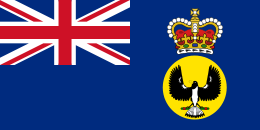Archibald Weigall
| Lieutenant Colonel Sir Archibald Weigall Bt KCMG | |
|---|---|
 | |
| 18th Governor of South Australia | |
|
In office 9 June 1920 – 30 May 1922 | |
| Monarch | George V |
| Premier | Henry Barwell (1920–22) |
| Preceded by | Sir Henry Galway |
| Succeeded by | Tom Bridges |
| Personal details | |
| Born | 8 December 1874 |
| Died | 3 June 1952 (aged 77) |
| Nationality | British |
Lieutenant Colonel Sir William Ernest George Archibald Weigall, 1st Baronet KCMG (8 December 1874 – 3 June 1952) was a British Conservative politician who was Governor of South Australia from 9 June 1920 until 30 May 1922.
Family
Weigall was the fifth son of a Victorian artist, Henry Weigall (best known for his portrait of Disraeli in 1878–1879), and his wife, Lady Rose Fane, daughter of John Fane, 11th Earl of Westmorland. Through his mother, he was connected to several powerful aristocratic dynasties. One of his older brothers was the cricketer Gerry Weigall (born Gerald John Villiers Weigall).
He married 16 August 1910 in Metheringham, Lincolnshire, a divorcee, Grace Emily, Baroness von Echardstein, née Grace Emily Blundell Maple (1876–1950), only surviving child of the deceased furniture magnate Sir John Blundell Maple (1845–1903) who had left a fortune of £2,153,000. She was the former wife of Baron Hermann von Eckardstein (1864–1933) of the German Embassy (whom she had married in 1896).[1] By his wife, Weigall had one daughter; his wife also suffered several miscarriages, including in Australia.
Their country residence was 'Englemere' at Ascot in Berkshire.
His daughter Priscilla married 1935 Edward Curzon, C.B.E. (1908–1984), son and heir of Francis Richard Henry Penn Curzon, 5th Earl Howe. They had two daughters before they divorced in 1943.
Weigall's great-grandson is British actor Jake Weber.
Early life and military career
Educated at Wellington College, Berkshire, and the Royal Agricultural College, Cirencester, Weigall became an estate manager.
He joined the 3rd (Militia) Battalion of the Northamptonshire Regiment (the Northampton and Rutland Militia), and served in the Second Boer War during 1900. He was promoted Captain on 4 April 1902,[2] and later Major. In World War I, he served with the Northamptonshire Regiment and on the staff, finishing with the rank of Lieutenant Colonel.
Political career
Captain Archibald G Weigall unsuccessfully fought the seat of Gainsborough for the Conservatives at the December 1910 general election.
He stood successfully in a by-election at Horncastle in Lincolnshire on 16 February 1911. The by-election was caused by the sitting Conservative MP Lord Willoughby d’ Eresby, who had held Horncastle at each election since 1895[3] succeeding to the peerage on the death of his father, Earl Ancaster. He received 4,955 votes, with a majority of 107 over the Liberal, Frederick Caesar Linfield.
He remained a MP until he resigned in 1920 to become governor.
Governor of South Australia

In 1919, Weigall accepted an appointment as Governor of South Australia. He was appointed KCMG in 1920, and soon left for Adelaide, arriving in June. He very quickly became disenchanted with the State Parliament; he became extremely frustrated with the way in which ministers would spend money before being granted supply, or transfer funds voted for one purpose to another. Although never explicitly calling for the abolition of the States, he did describe the results of the division of power in Australia as being "farcical" and "chaotic", and concluded that "State Governors and State Legislatures are now anachronisms".[4]
Weigall sought leave to resign in December 1921, citing "personal and financial" reasons. The Colonial Office had wrongly informed him that the State Government would pay the wages of his staff. This was not the case, and this left Weigall a wage of merely ₤300. His departure prompted Premier Henry Barwell to raise the Governor's salary.[4]
Due to the times, many of the war memorials in country towns around South Australia were opened by him as he travelled around the state, it being only a few years after the end of World War I. These include laying the foundation stone at Burra, unveiling the memorial at Hallett, and opening the new tennis courts at the Memorial Drive Tennis Centre in Adelaide.
Weigall Oval in the suburb of Plympton, and Weigall (formerly Woolshed Flat) along the River Murray were both named in his honour.
Later honours
He was appointed High Sheriff of Lincolnshire for 1926-27.[5]
Weigall was created a baronet, Weigall of Woodhall Spa, in 1938, and was made King of Arms of the Order of St Michael and St George also in 1938. He was appointed High Sheriff of Berkshire for 1944-45.[6]
Since he had no sons, his baronetcy died with him.
References
- ↑ Ordinarily, a marriage to a divorcee would have wrecked his career.
- ↑ The London Gazette: no. 27425. p. 2509. 15 April 1902.
- ↑ The Times, 26 December 2010
- 1 2 Australian Dictionary of Biography entry
- ↑ The London Gazette: no. 33143. p. 2012. 19 March 1926. Retrieved 6 March 2011.
- ↑ The London Gazette: no. 36444. p. 1449. 28 March 1944. Retrieved 23 March 2016.
| Government offices | ||
|---|---|---|
| Preceded by Sir Henry Galway |
Governor of South Australia 1920–1922 |
Succeeded by Sir Tom Bridges |
| Parliament of the United Kingdom | ||
| Preceded by Lord Willoughby de Eresby |
Member of Parliament for Horncastle 1911 – 1920 |
Succeeded by Stafford Hotchkin |
| Heraldic offices | ||
| Preceded by Sir Frank Swettenham |
King of Arms of the Order of St Michael and St George 1938–1952 |
Succeeded by Sir Nevile Bland |

